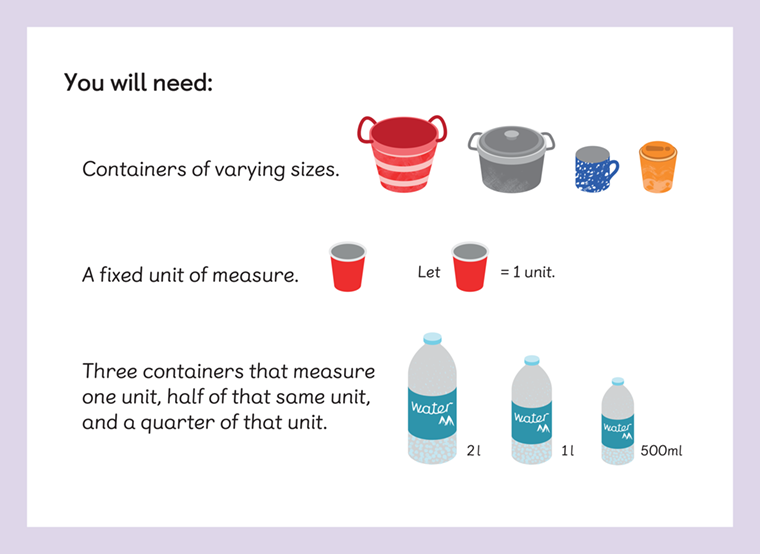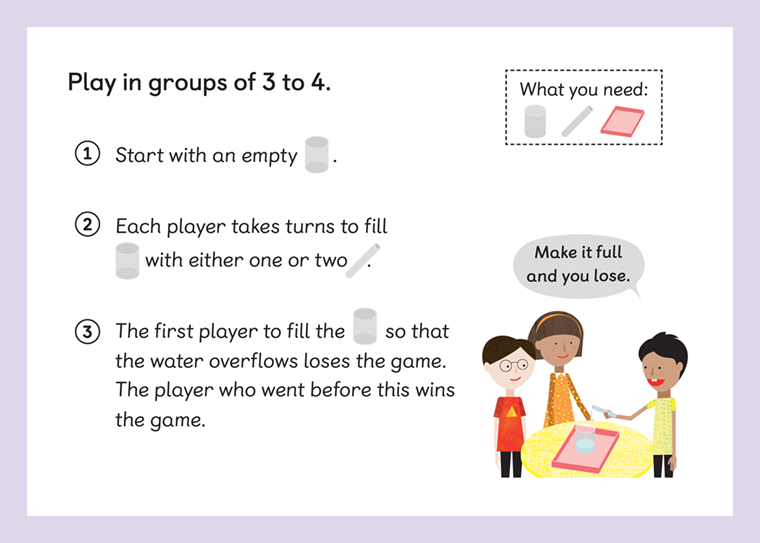Teaching Volume and Capacity in Year 1
Editor’s Note:
This is an updated version of a blog post published on July 28th 2017
Teaching Volume and Capacity in Year 1 from Maths — No Problem! Textbook 1B, Chapter 18 – Volume and Capacity
We decided to save volume and capacity for the final weeks of the term. After two terms and five weeks of learning, both children and adults in the classroom were starting to get a little… tired!
We hoped opportunities for practical work and group discussion would allow for a successful maths lesson with 30 slightly grumpy six-year-olds! This proved to be the case and provided us with both challenges and learning opportunities.
Following are three struggles and three successes we encountered when teaching this challenging topic.
3 Struggles when teaching volume and capacity
1. Resources
Resourcing practical topics, such as volume and capacity, can come with a range of challenges. Where to store them? Where to find them? Do you have enough of them? How long will it take to put them out in the classroom? If these were not difficult enough, this chapter comes with the additional challenge of endless trays of water being carted around the classroom!You will need:Another top tip for resources in this chapter is to put out trays of water on the table in advance with the containers inside. This gives groups access to enough water, yet avoids a lot of potential for mess! We had teaching assistants topping up trays with jugs of water to avoid pupils carrying water around the classroom.
You will need:
- Containers of varying sizes – we raided the school kitchen for bowls, jugs, mugs, etc.
- A fixed unit of measure – we used plastic cups. To support struggling learners, it is important that their containers fit an exact number of cups. They found it difficult if the capacity of the container was 4 and a bit cups. They could not understand this was ‘about’ 4 cups.
- For Lesson 3, three containers that measure one unit, a half of that same unit and a quarter of that unit, respectively. These can be tricky to locate. Try experimenting with a range of water bottles to find a match.

2. Language
The language around volume and capacity can be tricky. The words are not frequently used in daily conversation and can be confusing. For example, when your container is full, the capacity is equal to the volume but when your container is empty the capacity is the same but the volume is zero. We found it useful to split Lesson 2 for our classroom context.We taught a lesson on capacity with lots of practical activities and then taught volume afterwards. The children gained an understanding of capacity with the container full and could then link their learning to the new concept of volume.Put the vocabulary up on your working wall along with pictures to give the children a visual reminder and encourage collaborative learning.
3. Workbooks
For struggling learners, the workbooks were a challenge. In Year 1 there are children who are not fluent readers as well as EAL learners. It takes them a while to decode the questions and so the pace in lessons is slow and often they cannot comprehend what they have read. We found it helpful to work with these children on a one-to-one basis. We gave them strips of paper with keywords and phrases, for example, ‘more than’, ‘less than’ and ‘the same as’, to support their understanding.There is a page in the workbook (Lesson 2) where containers are filled to different heights and cups represent the amount of water inside. The children must calculate either volume or capacity by counting cups. It is important to question the children to ensure they understand whether they are calculating capacity or volume. Struggling learners simply counted the cups with no depth of understanding.
Transform Your Maths Assessment
Insights — our online assessment tool — gives you instant, powerful data to identify gaps and improve results.

3 Successes when teaching volume and capacity
1. Shared Learning
In each lesson the children had a practical activity to complete in their table groups with shared resources. Our classrooms were full of excited mathematical discussions that the children initiated themselves. The children enjoyed challenging each other with open questions and discovering new concepts for themselves.For example, one girl, when her table’s container was full, asked her friends, ‘If the volume was 5 cups, what was the capacity?’ As a table, they were then able to discover how, when the container was full, it meant the volume was the same as the capacity. It was wonderful to see them unpick their learning and use the language they had learnt so confidently. This chapter allowed peer-to-peer learning to happen through informal discussion.

2. Deep understanding
Upon reflection, and thinking back to how we previously taught volume and capacity before encountering the Singapore maths approach, we noted how different now the levels of understanding were among the children. This chapter provides lots of opportunities to really challenge and then secure their understanding, moving them towards mastery. We found the journals particularly useful. In some lessons, we stuck the In Focus task into the children’s journals and were impressed with how they showed their understanding in a variety of ways. They could draw pictures of the problem and write sentences explaining how they knew the volume and capacity. In another lesson, we asked the children to order three pictures from empty to full and explain why they chose this order. Finally, we stuck in pictures of the children doing the practical activity and asked them to explain what they had learnt. Deep questioning and opportunities for the children to articulate concepts meant we knew they had developed a good understanding of the topic.
3. Fun!
This chapter was fun! The children enjoyed experimenting with water. They liked talking with their friends and playing games. For example, we had the children take turns to fill containers with plastic syringes. They saw themselves as scientists experimenting! We found they were engaged throughout lessons and maintained focus for longer periods of time. There was even an opportunity for a Year 1 game where the children took turns to pour cups of water into containers in teams. The first team to find the capacity of their container won!This was the perfect chapter to end a wonderful year of new and exciting learning.
Teaching Place Value?
Check out our comprehensive guide for teaching Place Value for Year 1

